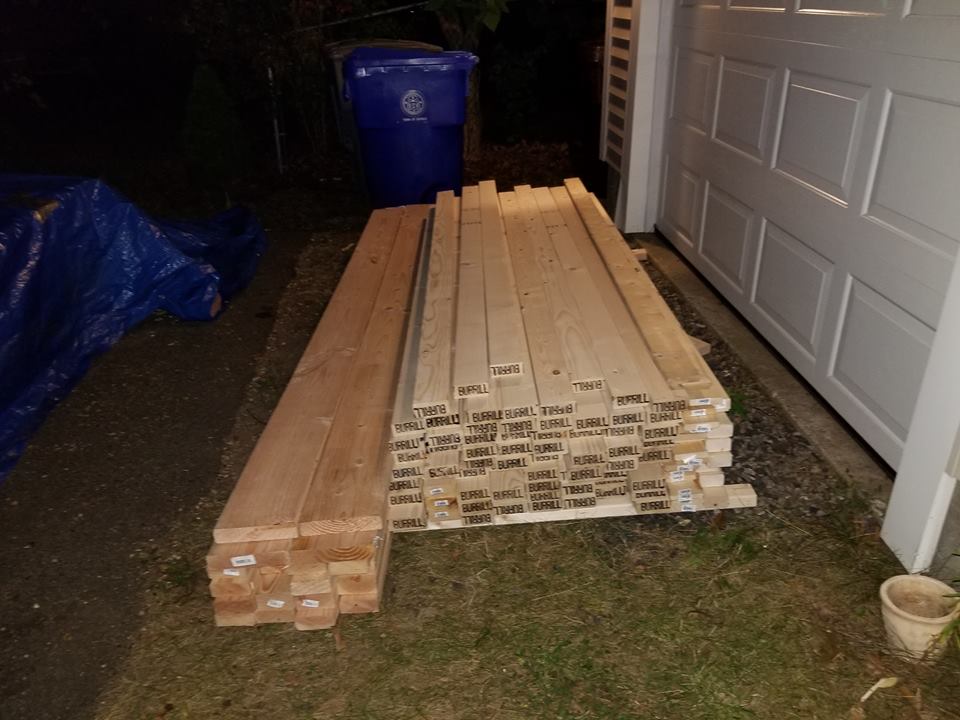
First load of lumber. This will turn into walls soon.
Mostly 2x4s (a handful are 10ft for top & bottom plates; the rest are 8ft). Some 2x8s for widow and door headers. Some 2x3s for standoffs/junk/brace/utility. Some 1×4 for wall section bracing to keep them square.

I spent 14 hours on FRHT today and there’s nothing really worth taking a picture of just yet. How can that be, you ask? Well…
1. Clean out all the threaded-rod receivers with WD-40 and 90 PSI bursts of compressed air. Nothing to see.
2. Check trailer for level on all four sides, at angles, and variously elsewhere. Nothing to show.
3. Apply duct tape to all deck seams to help keep rain out of the insulation bays (where it could foster mold). Yes, there’s a tarp, but as soon as the walls go up and before the roof is up, there will likely be some exposure to the weather. This I could have taken a picture of, but really, it’s just the deck like before, only now with gray stripes.
4. Carefully lay out reference lines for the walls on four sides, verify they are square and parallel as best I can, compensate for slight variations of things. Very long pencil lines on the deck. Not exactly photogenic, though it represents surprisingly much work.
5. Lay out all nearly all the walls. The output of this is a handful of sketches and a small pile of lumber with pencil marks all over them. This is almost photo-worthy, but by the time I was done it was too dark for photos given the fine details (pencil lines). I’ll probably snap a pic when I return to work in the morning.
What took so much time was that there was design going on at the same time as layout. It kinda went like this: mark off stud locations 16″ OC. Mark where threaded-rod hold-downs go. Where’s a good place to end this wall module according to windows and hold-down locations? Think about windows. Where’s a good place for a window? How big should it be? Does it need to align/avoid anything? Okay, get out the tablet, go window shopping. Literally. Shopping for windows. Locate window of suitable dimensions and configuration. Contemplate how the chosen window location affects the stud layout. Revise as needed. Contemplate the room function and how things might be arranged in there. Does this window need to be above or below anything? Edit the sketch. Pencil in the framing for the window on the “sole plate” (that’s the horizontal lumber at the foot of the wall).
Wait… with the bed in the stowed (folded up) position, the room is 16″ shallower than before (bed thickness becomes added to one wall). Should the window be centered on that shorter distance? Probably. Unless there’s a reason not to. Is there a reason not to? More contemplation.
Then there’s that doorway. I just realized the slope of the roof is backwards (runoff toward the door). The high side should be the door side and the loft stairs, previously specified for the opposite wall (which was going to be the high wall, you see) need to be moved to the door side. Which means swapping 1/3 of the first floor and all of the second floor aorund. Wait… check the math… how high can this wall go before it’s too high for the DOT? Quick, research standing seam metal roofing to get a sense of how thick the roof will be (add that to plywood, add that to rafter thickness… quick, sketch the roof system in profile to be sure it all adds up right and doesn’t go over) … yeah. It was like that. All day.
But now I have 6.5 of the 8 wall sections laid out. Lots of windows chosen. All the reference lines are on the deck, which is now a bit more water-resistant than it was yesterday. I’m certain everyting is flat, square, and level. The threaded rod receivers are as cleaned out as they can be (this was a real problem – the rods were binding badly due to fine particles caught in the threads). The wall sections are partitioned sensibly. I have confirmed that I’m not going to build it too high. I’ve re-arranged parts of the first floor and all of the second floor (on paper/in my head). Shopped for windows. So, yeah, a ton of work, but not much to *see* today.
Tomorrow, on the other hand, is going to generate a bunch of physical output. After a relatively short period laying out the remaining walls (I already have favorite windows, so
choosing them is quick now and the function of the remaining space is well understood), it’s time to actually BUILD THEM.
I had been thinking that these would get built on saw horses or on the ground, or even on the trailer deck (horizontally), then set aside until raising day. The hard part about that was getting these heavy wall systems (even at 8×7, they’re gonna be heavy) up onto the trailer deck again (26″ or so from ground level – higher in some spots, the ground isn’t level) with any degree of control and grace. And then my brain turned back on. Build the wall sections flat on the deck, as I had planned, but then LEAVE THEM THERE. Stack ’em up, in fact. Then, when it’s time to raise the walls, all I have to do is pivot them to vertical (imagine opening a cardboard moving box) rather than actually lift them wholesale up onto the deck. Walk them to position. Presto! To keep them from sliding off the edge of the deck, a temporary brace will be installed along the perimeter to catch the foot of the wall sections. Now it’ll be a relatively simple matter of standing them up, installing cross bracing to hold them in place, and that’s it! Hey, it might even be easy! Go brain!
But first, I must actually finish the last little bit of design / layout and then build the sections. The building should go pretty quickly – cut, place on line, clamp, nail, cut, place on line, clamp, nail – with a pneumatic nail gun, it should be no problem to get all 8 sections built during daylight. Especially if I don’t have to manhandle them off the deck for staging (as previously planned). Just leave ’em in place, stacked up flat, ready to stand. Yes. That’s exactly what I will do.